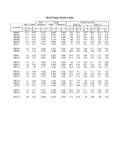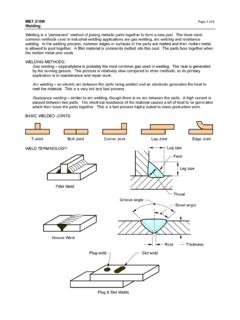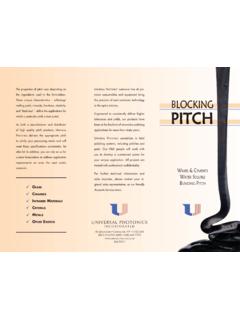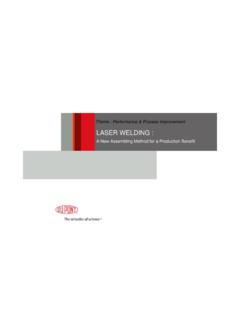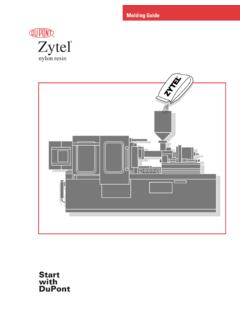Transcription of I. Thermoplastics (commodity) - Pennsylvania State …
1 I. Thermoplastics ( commodity ): Polyethylene (PE). Description The material POLYETHYLENE, (-CH2-)n, first synthesized in 1933, looks like the simplest of molecules, but the number of ways in which the - CH2 - units can be linked is large. It is the first of the polyolefins, the bulk thermoplastic polymers that account for a dominant fraction of all polymer consumption. Polyethylene is inert, and extremely resistant to fresh and salt water, food, and most water-based solutions. Because of this it is widely used in household products, food containers like Tupperware and chopping boards. Polyethylene is cheap, and particularly easy to mold and fabricate. It accepts a wide range of colors, can be transparent, translucent or opaque, has a pleasant, slightly waxy feel, can be textured or metal coated, but is difficult to print on. Composition (-CH2-CH2-)n Image _. Caption PE is widely used for containers and packaging.
2 General properties Density - lb/ft^3. Price - USD/lb Mechanical properties Young's modulus - 10^6 psi Shear modulus * - 10^6 psi Bulk modulus - 10^6 psi Poisson's ratio * - Yield strength (elastic limit) - ksi Tensile strength - ksi Compressive strength - ksi Elongation 200 - 800 %. Hardness - Vickers - HV. Fatigue strength at 10^7 cycles - ksi Fracture toughness * - ^1/2. Mechanical loss coefficient * - Thermal properties Thermal conductor or insulator? Good insulator Thermal conductivity - ^ Thermal expansion coefficient 70 - 110 strain/ F. Specific heat * - Melting point - F. Glass temperature - F. Maximum service temperature * 194 - 230 F. Minimum service temperature * - F. Electrical properties Electrical conductor or insulator? Good insulator Electrical resistivity - 3e24 Dielectric constant (relative permittivity) - Dissipation factor (dielectric loss tangent) * 3e-4 - 6e-4. Dielectric strength (dielectric breakdown) - V/mil Optical properties Transparency Translucent Refractive index - Eco properties, material production Embodied energy 8331 - 9209 kcal/lb CO2 footprint - kg/kg Eco properties, processing Polymer molding energy 1027 - 1255 kcal/lb Polymer extrusion energy - kcal/lb Eco properties, recycling and disposal Recycle True Downcycle True Combust for energy recovery True Biodegrade False Landfill True A renewable resource?
3 False Recycle mark _. Environmental notes PE is FDA compliant - indeed it is so non-toxic that it can be embedded in the human body (heart valves, hip-joint cups, artificial artery). PE, PP and PVC are made by processes that are relatively energy-efficient, making them the least energy-intensive of commodity polymers. The ethylene from which it is made at present is an oil derivative, but PE can be produced from renewable resources - from alcohol derived from the fermentation of sugar or starch, for instance. Its utility per kilogram far exceeds that of gasoline or fuel-oil (and its energy is stored and still accessible), so that production from oil will not disadvantage it in the near future. Polyethylene is readily recyclable if it has not been coated with other materials, and - if contaminated - it can be incinerated to recover the energy it contains. Processability Castability 1 - 2. Moldability 4 - 5.
4 Machinability 3 - 4. Weldability 5. Durability Flammability Flammable Fresh water Very good Salt water Very good Weak acids Very good Strong acid Good Weak alkalis Good Strong alkalis Good Organic solvents Average Sunlight (UV radiation) Good Oxidation at 500C Very poor Supporting information Design guidelines PE is commercially produced as film, sheet, rod, foam and fiber. Drawn PE fiber has exceptional mechanical stiffness and strength, exploited in geo-textile and structural uses. PE is a good electrical insulator with low dielectric loss, so suitable for containers for microwave cooking. It has poor resistance to aromatics and chlorine; it is slow burning in fire. PE is cheap, easy to form, biologically inert and recyclable; it is one of the materials of the next 20 years. Technical notes Low density polyethylene (LDPE), used for film and packaging, has branched chains which do not pack well, making it less dense than water.
5 Medium (MDPE) and High (HDPE) density polyethylenes have longer, less branched chains, making them stiffer and stronger; they are used for containers and pipes. Modern catalysis allows side-branching to be suppressed and molecular length to be controlled precisely, permitting precise tailoring both of the processing properties critical for drawing, blow molding, injection molding or extrusion and the use-properties of softening temperature, flexibility and toughness. Linear low-density polyethylene (LLPDE) is an example. In its pure form it is less resistant to organic solvents, but even this can be overcome by converting its surface to a fluoro-polymer by exposing it to fluorine gas. Treated in this way (when it known is known as 'Super PE') it can be used for petrol tanks in cars and copes with oil, cleaning fluid, cosmetics and that most corrosive of substances: cola concentrate. Very low density polyethylene (VDLPE) is similar to EVA and plasticized PVC.
6 Typical uses Oil container, street bollards, milk bottles, toys, beer crate, food packaging, shrink wrap, squeeze tubes, disposable clothing, plastic bags, paper coatings, cable insulation, artificial joints, and as fibers - low cost ropes and packing tape reinforcement. Tradenames Alathon, Aquathene, Bapolene, Dowlex, Eltex, Empee, Eraclene, Ferrene, Fortiflex, HiVal, Hid, Kemcor, Lacqtene, Lupolen, Marlex, Nortuff, Novapol, Paxon, Petrothene, Polyfort, Rigidex, Sclair, Stamylyn, Statoil, Unival, Zemid Links Reference ProcessUniverse Producers No warranty is given for the accuracy of this data. Values marked * are estimates. Polystyrene (PS). Description The material Polystyrene is an optically clear, cheap, easily molded polymer, familiar as the standard "jewel". CD case. In its simplest form PS is brittle. Its mechanical properties are dramatically improved by blending with polybutadiene, but with a loss of optical transparency.
7 High impact PS (10%. polybutadiene) is much stronger even at low temperatures (meaning strength down to -12C). The single largest use of PS is a foam packaging. Composition (CH(C6H5)-CH2)n Image _. Caption Polystyrene is water-clear, easily formed and cheap. General properties Density - lb/ft^3. Price * - USD/lb Mechanical properties Young's modulus - 10^6 psi Shear modulus - 10^6 psi Bulk modulus - 10^6 psi Poisson's ratio - Yield strength (elastic limit) - ksi Tensile strength - ksi Compressive strength - ksi Elongation - %. Hardness - Vickers - HV. Fatigue strength at 10^7 cycles - ksi Fracture toughness - ^1/2. Mechanical loss coefficient - Thermal properties Thermal conductor or insulator? Good insulator Thermal conductivity - ^ Thermal expansion coefficient 50 - 85 strain/ F. Specific heat - Glass temperature - F. Maximum service temperature - F. Minimum service temperature - F. Electrical properties Electrical conductor or insulator?
8 Good insulator Electrical resistivity 1e25 - 1e27 Dielectric constant (relative permittivity) 3 - Dissipation factor (dielectric loss tangent) 1e-3 - 3e-3. Dielectric strength (dielectric breakdown) - 574 V/mil Optical properties Transparency Optical Quality Refractive index - Eco properties, material production Embodied energy - kcal/lb CO2 footprint - kg/kg Eco properties, processing Polymer molding energy 1136 - 1388 kcal/lb Polymer extrusion energy - kcal/lb Eco properties, recycling and disposal Recycle True Downcycle True Combust for energy recovery True Biodegrade False Landfill True A renewable resource? False Recycle mark _. Environmental notes The flammability of PS foam, and the use of CFC's as blowing agents in the foaming process was, at one time, a cause for concern. New flame retardants allow PS foams to meet current fire safety standards, and CFC blowing agents have been replaced by pentane, CO2 or HFC's which do not have a damaging effect on the ozone layer.
9 PS can be recycled. The large volume of PS. foam in packaging, much of it dumped at present, is a cause for concern. The monomer, styrene, is irritating to the eyes and throat, but none survives in the polymer. Processability Castability 1 - 2. Moldability 4 - 5. Machinability 3 - 4. Weldability 5. Durability Flammability Flammable Fresh water Very good Salt water Very good Weak acids Good Strong acid Average Weak alkalis Very good Strong alkalis Average Organic solvents Poor Sunlight (UV radiation) Average Oxidation at 500C Very poor Supporting information Design guidelines PS comes in 3 guises: as the simple material ('general purpose PS'); as the high impact variant, blended with polybutadiene; and as polystyrene foam, the most familiar and cheapest of all polymer foams. All are FDA approved for use as food containers and packaging. General purpose PS is easy to mold. Its extreme clarity, ability to be colored, and high refractive index give it a glass-like sparkle, but it is brittle and cracks easily (think of CD cases).
10 It is used when the optical attractiveness and the low cost are sought, and the mechanical loading is light: cosmetic compacts, transparent but disposable glasses, cassettes of all kinds. Medium and high impact polystyrenes trade their optical for their mechanical properties. Medium impact PS, translucent, appears in electrical switch gears and circuit breakers, coat hangers and combs. High impact PS - a blend of PPO and PS, is opaque, but is tough and copes better with low temperatures than most plastics; it is found in interiors of refrigerators and freezers, and in food trays such as those for margarine and yogurt. Other styrene blends, like Kraton, have low tensile strength and higher elongation than SBR or natural rubber. PS can be foamed to a very low density (roughly 1/3 of all polystyrene in foamed). These foams have low thermal conduction and are cheap, and so are used for house insulation, jackets for water boilers, insulation for disposable cups.
